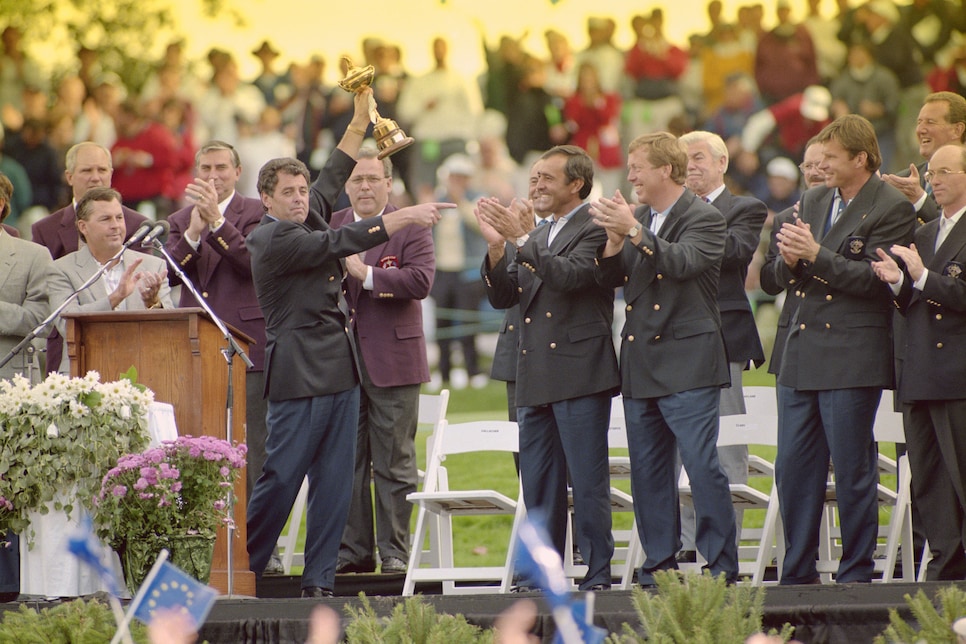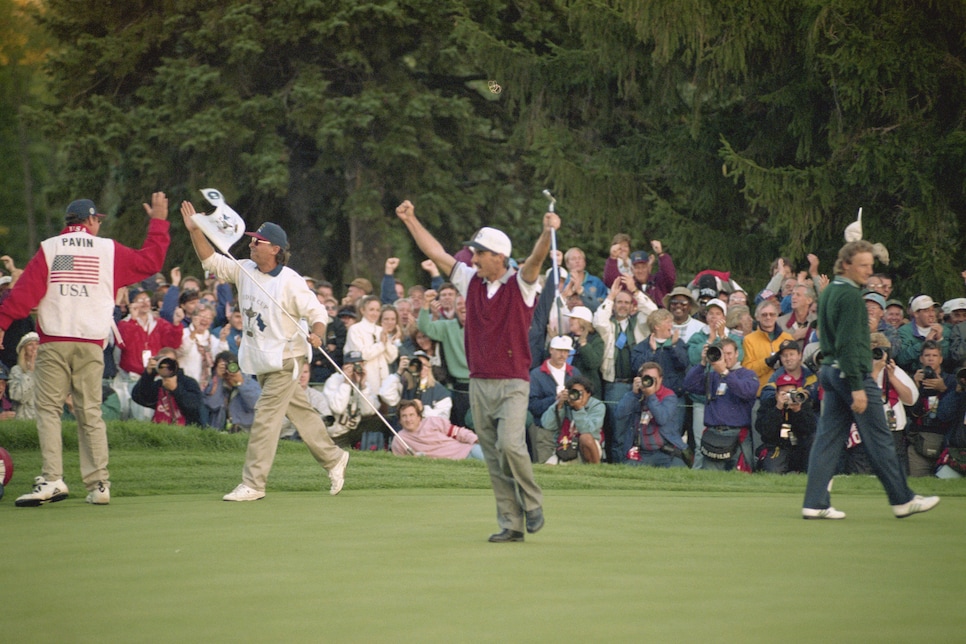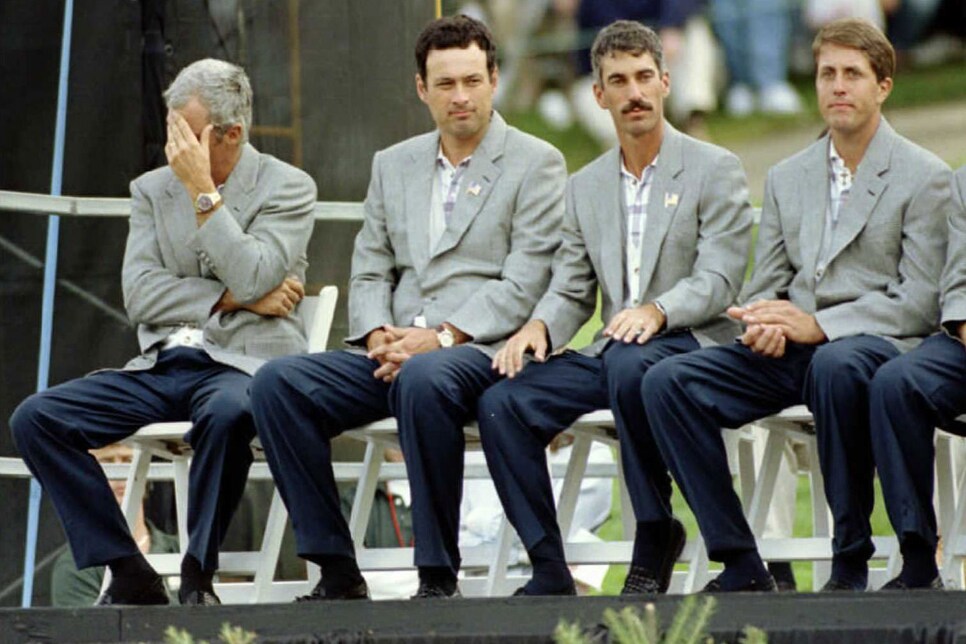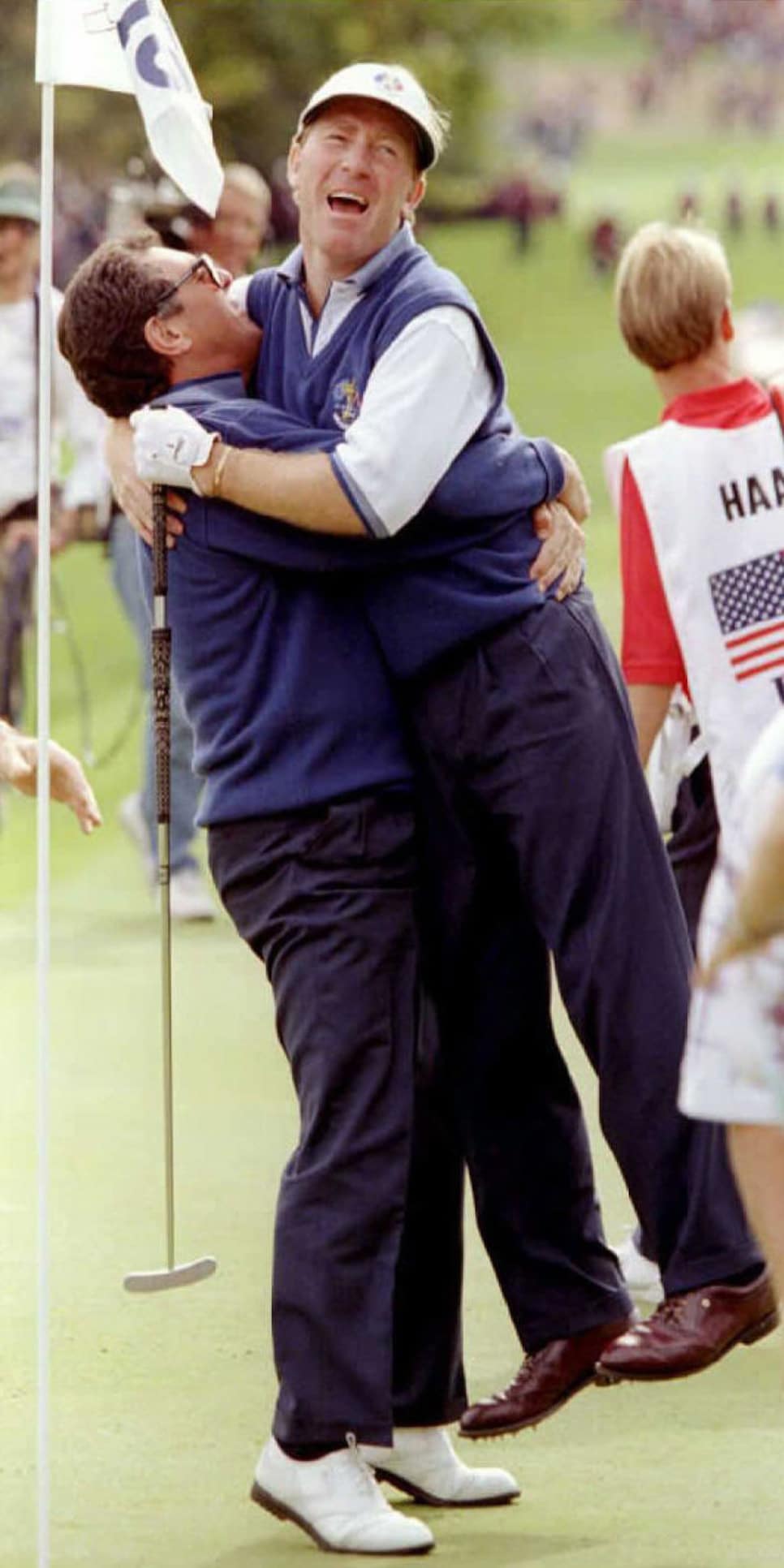Oak Hill Memories
PGA Championship 2023: When Oak Hill hosted history's most underrated Ryder Cup

You could argue that it started with a defunct newspaper. In 1941, the Rochester Times-Union raised a $5,000 purse for a tournament to be held at the Donald Ross-designed East course at Oak Hill Country Club, host of this year's PGA Championship. That was plenty to attract the likes of Ben Hogan, Sam Snead and Walter Hagen, and though it only lasted two years—Snead won in '41, Hogan in '42—the make-shift event was enough to put Oak Hill on the map. After that, the course hosted two U.S. Amateurs, three U.S. Opens, and four PGA Championships counting this year’s event at the newly renovated East Course. And in 1995, the PGA of America brought its other marquee event, the Ryder Cup, to upstate New York.
The golden age of the Ryder Cup, at least as defined by the closeness of the matches, fell between 1983 and 1999, with classics at Muirfield Village, Kiawah, and Brookline punctuating the drama. Often lost in that mix of tremendous golf is the 1995 match at Oak Hill. For three days in late September, the U.S. team captained by Lanny Wadkins (in Tony Jacklin's words, "the cockiest son of a bitch you ever met in 10 lifetimes … but in the nicest way") took on Bernard Gallacher's Europeans in an effort to maintain the American mo-jo from their’ dramatic comeback win in the Belfry in '93. What transpired was not only another nailbiter, but one that perhaps introduced the possibility of a wild Sunday swing—the kind that would reach its wildest form at Brookline and Medinah.
As a captain, Wadkins was a harbinger of the future—incredibly organized, efficient and seeing out every aspect of his job to the last detail, including, as Peter Jacobsen later noted, clothing and shoes and dinners and accommodations and scheduling. But there was a bit of the maverick in Wadkins as well, and he came under scrutiny when he selected Curtis Strange, then 40, and Fred Couples, 35, with his two captain's picks. They were 23rd and 34th in the points standings, respectively, but Strange was the more controversial pick since he hadn't won a PGA Tour event in six years. What he had won was the '89 U.S. Open at Oak Hill, and that horses-for-courses philosophy, plus the fact that Strange shared Wadkins' combative energy, seemed to drive the decision to leave out a red-hot Lee Janzen and that year’s Open winner, John Daly. This choice played a massive role in what was about to unfold in Rochester.

The opening ceremony for the 1995 was held under sunny skies on the practice area at Oak Hill.
Simon Bruty
Both sides brought experienced rosters to the event. Europe boasted veterans like Nick Faldo, Ian Woosnam, Bernhard Langer and Sam Torrance, while the U.S. countered with the likes of Corey Pavin, Ben Crenshaw, Jacobsen and Jay Haas. The average age of both teams was 36, and though the U.S. had some older "rookies" in Loren Roberts, Brad Faxon (who put together a spectacular final-round 63 weeks earlier at the PGA Championship to qualify) and Tom Lehman, there was only one player on each team younger than 30. For Europe that was Per-Ulrik Johansson, and for the U.S. it was a 25-year-old who would go on to play in the most matches in Ryder Cup history: Phil Mickelson.
Over three days of competition, nerves ran rampant as they only can when a close match is almost a given. The end result would come down to a drama-packed final afternoon that should be remembered not just for its tension and excitement, but for how it solidified a new Ryder Cup truth—Europe’s momentum was real, and it was permanent.
The Pairs Sessions
An overcast sky greeted Colin Montgomerie on the first tee at the start of Friday morning foursomes as he contemplated his club selection. "I want to hit the driver because it's the biggest club in the bag and I've got less chance of missing the ball altogether," the nervous Scot told his caddie. Those ominous clouds would soon give way to a driving rain that would swamp the course to such a degree that certain greens would have to be squeegeed during play. Montgomerie chose the 3-wood and hit it straight, but Tom Lehman, juiced up on adrenaline, sent a 3-wood soaring 320 yards, Pavin hit the approach to 10 feet, and Lehman made the birdie putt to win the hole. That set the tone against Montgomerie and Faldo, and on the 18th hole, a frustrated Faldo missed his drive and then played a poor chip that handed the Americans the first point.
In the anchor match, Bernhard Langer hit a massive match-winner on 18, but the effort by his opponents, Ben Crenshaw and Curtis Strange, to extend the match proved important. Why? Because when Gallacher had to make afternoon lineups, he thought Langer and Johansson's big early lead meant they'd be done early. Instead, they came off the course drenched and tired on the 18th hole, had just a half-hour break and, exhausted, trudged back out to face the team of Pavin and Mickleson (in Mickelson's first Ryder Cup match). The Americans trounced them, 6 and 4, Couples and Love dealt Faldo and Montgomerie their second loss of the day, and Maggart and Loren Roberts struck a 6-and-5 blow against Torrance and Rocca.

Phil Mickelson was making his Ryder Cup debut at Oak Hill with a firey captain in Lanny Wadkins handling all the off-course matters to allow players to focus solely on their games.
PGA of America
The only match the Europeans won on Friday afternoon came from the team of Seve Ballesteros—a legend playing in his last Ryder Cup, and far past his prime—and the part-time cattle breeder David Gilford. Gilford had been the unfortunate player who had to sit out Sunday singles for Europe in 1991 when American Steve Pate got in a car crash, and he had been devastated to learn that it was his name in Gallacher's envelope. Now he was back, and with Ballesteros effectively taking on the role of caddie—"He never let Gilford out of his sight," Faxon later remembered of Seve—he had to carry the team in the midst of a U.S. onslaught.
"I only played in three matches in 1995, and I hit three fairways the whole week," Seve said later, "but I cleared out a lot of rough and all the branches on the golf course. I'm sure the members of Oak Hill weren't going to lose balls any more after I'd been there."
The Americans made an enormous mistake on seven when Jacobson failed to realize that Faxon had taken a penalty drop after his tee shot and, assuming his partner was in for a par, picked up his own par putt. That meant a lost hole, and on 13, Gilford drained a winding 18-footer from off the green for birdie, which led to an embrace of such strength from Seve that Gilford's hat flew off. In the end, they won 4 and 3, and the Europeans staved off total disaster. By day’s end, the Americans led 5-3, and Faxon left Jacobson alone to be hounded by the press for his mistake on seven.
Saturday was a classic tale of two sessions, with the Europeans roaring out to a 3-1 lead in foursomes, tying the Cup at 6-6. The highlight of that session came when Rocca, paired with Sam Torrance, found himself matched against Davis Love III in a repeat of the disastrous singles match he had lost at the Belfry in ‘93, leading to headlines like “Rocca the Choka” in the British press. Strangely, Rocca wasn't nervous, and on the sixth hole, he hit a beautiful 6 -iron that went in the hole for the third ace in Ryder Cup history. He and Torrance won, 6 and 5, Gilford got his second win, this time with Langer, and Faldo and Montgomerie got their act together to win the first match, 4 and 2, which incidentally made captain's pick Curtis Strange 0-2 for the event. He wouldn't play in the afternoon.
Those who did play rescued the day for the Americans, reversing the 3-1 morning debacle. The Scots—Gallacher, Torrance and Montgomerie—conspired to pair up the latter two for the fourball session, but Faxon and Couples were red-hot and dealt them a 4-and-2 loss. When Couples chipped in on the 14th, Faxon described it as the loudest roar he had ever heard from the gallery, Torrance concurred, and even Couples, normally in control of his emotions, "went nuts," per Faxon. "And the crowd were like animals."
Before the players reached the 15th tee, Torrance sidled up to Couples for a private word.
"I whispered in his ear, 'fuck you,'" Torrance said later. "And he laughed, he really laughed. But he told me a little while later that he told the rest of the American team and some of the young guys couldn't that I'd said that to him, thinking I was serious."
In the last match, Corey Pavin was carrying Loren Roberts against Faldo and Langer. On 18, all square, Faldo gave himself an 18-foot look at birdie, and the Americans were in trouble—Roberts was 40-feet away, and Pavin was in the long rough. Roberts went first, and got close enough to have the par conceded, and the Europeans started thinking about winning the match outright with Faldo's birdie try. Instead, Pavin chipped in, triggering another deafening roar from the gallery. Faldo missed, and as the sun fell on Saturday, the Americans led 9-7; their first lead heading into Sunday since 1981. If they had gone on to win, it's likely Pavin's shot would still be considered one of the most legendary in Ryder Cup history.

Corey Pavin's chip in allows the U.S. to take a 9-7 into Sunday singles, the first lead the Americans had entering the final session since 1981.
Getty Images
Sunday Singles
The singles session started off with a European twist—while Wadkins led off with Tom Lehman, one of his strongest players, Gallacher threw a curveball by posting Seve in the No. 1 spot. He left his two rookies at the end, a massive risk, and threw his strength into the middle. The Spaniard used every bit of his short-game magic to keep things close, and the Europeans behind him on the course, knowing full well how poor his play had been that week, were astounded to see him all square at the turn.
"I said to one of the marshals, 'How is Seve doing?'" Howard Clark recalled. "And he said, 'he's all square.' I said, 'you are kidding me, that's amazing.' … I kind of thought, 'I have got to try and back him up, because if he is going to win, I have got to win, too."
Montgomerie maintains to this day that if Seve's opponent had been anyone but Lehman, they would have folded. But Lehman's form was strong (he would win the Open Championship the next year), and in the end he prevailed, 4 and 3.
That's when things started going south for the Americans. In the second slot, Clark showcased a phenomenal short game in an otherwise ugly match, struck an ace on the par-3 11th with Jacobson just 20 feet away, and won, 1 up. Mark James ran over Jeff Maggart, Couples could only manage a half point against Ian Woosnam when he holed his six-foot part at the last, and though Love beat Rocca in singles again—of course fate matched them up—Gilford scrambled like a madman for his last four holes, and made a 15-foot bogey putt on 18 to hold off Faxon for a 1-up win and total redemption for 1991. (Afterward, NBC's Jimmy Roberts spotted Faxon in the parking lot sobbing—he knew how big his loss had been.)
Montgomerie beat Crenshaw, and in the eighth match came the most pivotal battle of all: Faldo vs. Strange, both captain's picks. Strange was 1 up on 16, but Faldo, knowing Europe had a legitimate chance to win, squared it up heading into 18. He pulled his drive, Strange hit down the middle, and the situation looked desperate. Faldo pitched out to 90 yards, but Strange came up well short of the green, and with the tension mounting, Faldo stepped up for his third.
"We had 93 yards to go," said his caddie Fanny Sunesson, "it was the middle-wedge, and he just got the most perfect stroke on it, pitched nicely and ran to about four feet just left of the hole with an uphill putt."
Strange's chip settled about five feet away from the hole, and to the astonishment of the crowd, he missed. Faldo lined up. "The pressure was immense," he said, "everything was shaking … everything except my putter." He sent it home, and Europe had another point. As he walked off the green, Ballesteros was waiting for him, tears in his eyes. He hugged Faldo and said, "you are a great champion."
"That was the greatest moment of my career," Faldo remembered.
For his opponent Strange, the scene at the last hole was a living nightmare. "When I was standing on the 18th green, I knew what was going to happen to me," Strange said. "They were going to hang me out to dry. … It hurt for a long time because it was such a big deal."

Curtis Strange's disappointment couldn't be hidden at the closing ceremony, having gone 0-3 including a Sunday singles loss as captain's pick for Team USA.
JOHN RUTHROFF
At the closing ceremony, after bravely facing the press, photographers caught Strange burying his face in his hands—the moment he cracked. And his prophecy was right, because of all the coverage that stung him, the Sports Illustrated headline hurt the most: "WRONG MAN, WRONG TIME."
When Torrance won, Pavin beat Langer, and Mickelson closed out a perfect 3-0 Ryder Cup with a 2-and-1 win over Johansson, there was just one match left on the course: Philip Walton against Jay Haas. If Walton could win, Europe would have pulled off the shocking 14½ -13½ triumph. A loss or a tie, and the Americans would hold on to the Cup.
"A few glances up at the scoreboard set the nerves jangling, knowing just how crucial our match had become," said Walton’s caddie, Bryan McLauchlan. "It was nerve-wracking then, dry-mouthed, hands shaking, head spinning—and that was just me. Philip seemed as cool as a cucumber. I was through cigarette after cigarette."
On the par-3 15th, with 186 yards to the pin, Walton hit a 6-iron to six feet, made the downhill birdie putt, and took a 3-up lead with three to play. It was nearly in the bag for Europe, but Haas had some fight left in him. He holed a miracle shot from the bunker on 16, scrambled for par on 17, and took the match to the last hole. Neither player hit the fairway on 18, but while Haas punched out, Walton advanced the ball to the front bank of the green. Using a tip from Woosnam, he pitched to 12 feet, and when Haas couldn't hole out from behind the green, Walton had two putts for the win. His caddie McLauchlan tried to give him a read, but Walton replied, "Brian, I've got two putts for it. I think I'll take them."
"Afterwards he told me his legs were shaking so much he didn't know whether they were his or John Travolta's,” McLauchlan said. “But he rolled up to about five inches. Jay came over and shook his hand."

Philip Walton gets a hug from captain Bernard Gallacher after sinking his putt on the 18th hole to win the Ryder Cup for Europe.
TIMOTHY A. CLARY
The champagne was popped, celebrations ensued amid a silent crowd, and the Americans had to watch as Europe won for the second time in the U.S.
"When Lanny had to go up there and make his concession speech during the closing ceremonies, he put these bicols on and started to try and praise his own team and commend his opponents," Jimmy Roberts remembered. "And it was obviously very difficult for him. His voice started to break and crack, and just when it looked as if he was going to be in some impossible spot, Bernard Gallacher got up."
The Scottish captain, who knew his counterpart was struggling, put an arm around his shoulder.
"Let me help you, Lanny," said the captain who was on the losing side of the two previous Ryder Cups. "I've been there before."


